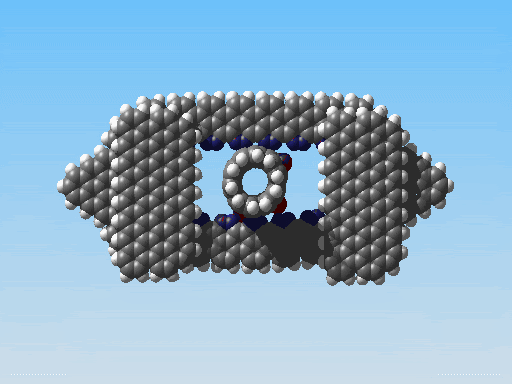Instead of brass I made my rack out of a graphene sheet, carved out to make two rows of linear teeth and end points. I capped the exposed inner carbon atoms with nitrogen. This was inspired by the nitrogen caps I used for the clutch plate on the simple nanotube clutch. For my "mutilated pinion" I inserted a pre-made carbon nanotube from the parts library. I transmuted six carbon atoms from sp2 to sp3 and place one oxygen sp3 atom across each carbon couplet to complete the pinion. To keep the rack aligned I placed four additional graphene plates with multiple anchors around their perimeter.
I guess some more alignment plates are needed? My favorite part is when after the rack flies off, all the hydrogen atoms go flying too; I can almost hear them go "Boing!"


2 comments:
More alignment plates aren't going to help. Graphene just doesn't have the sort of stiffness you need in multiple dimensions -- the only thing that is resisting the flexing is that when it isn't flat aromaticity is disrupted. Remember, bonds are not pieces of steel -- they can stretch and flex. (Indeed, the quantum harmonic oscillator model for bond vibration says that they're constantly doing just that.)
You want to have enough redundancy in there to get substantial stiffness in the face of the force you are applying. I'd suggest using a structure several atoms thick at least -- perhaps a diamondoid structure of some sort. You might find it helpful to compare the force you are applying to the force needed to distort bonds.
Lastly, I would be more careful about the use of pyridine-like structures in place of hydrogens for terminating conjugated ring structures. The molecular mechanics models you are using may or may not reveal unfortunate chemistry at the lone pairs on the nitrogens, and may or may not reveal destabilization effects. Nitrogen is not simply "carbon that bonds only three times". Your usage might be completely fine, or it might not -- you may need some more detailed calculations to know. (The clutch may be even worse on this.)
Brutish conservatism is probably the right thing in early design. It is okay to waste atoms getting to something that will certainly work vs. extra elegance that cannot be well validated in advance with the primitive tools we currently possess.
Hey!
Thanks. That is really helpful. Hope you stick around here.
Tom
Post a Comment